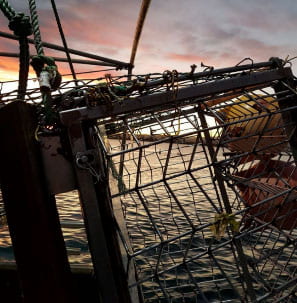Selective trawl gear is also of interest to innovative small fishing companies, with a growing interest in gear that can reduce the bycatch of undersize and unwanted fish. In response to this issue, Karl Warr – the owner/operator of Better Fishing Ltd in Te Matau-a-Māui Hawke’s Bay – came up with an idea for a rigid steel trawling cage with square mesh panels to replace the narrow end of the tapered trawl net where the fish accumulate. The aim was to selectively catch fish based on their size and create a low water flow area so that fish in the cage are in a less stressful environment. In 2013, he worked with a local engineer to build it and opted for open-source model so that wider industry could also access the technology to maximise the sustainability benefits.
Trials of the cage demonstrated an 80-90% reduction of undersized sand flounder compared to a conventional trawl net and a 95% reduction in juvenile fish mortality.[1] After validating the approach, Karl now exclusively uses the selective fishing method, changing out the side panels to a particular gate size to match the species he is targeting.
His desire to continuously improve the sustainability of his operation led Karl to think of further ways he could refine his approach to be even more selective. Ultimately, he was aiming for a mechanism that could help him fish precisely for his orders that day. Recognising what was in the trawl and choosing to keep or release it in real time underwater could achieve just that.
Karl initially faced a few setbacks in taking this idea further, with unsuccessful applications to various local funding rounds. As a small independent fisher, he did not have the capital to invest in the idea himself, nor did he have experience in applying for research funding, or the support or backing of industry that the larger companies may have. Aside from limited access to capital, a key barrier was not having connections to researchers to progress his vision.
Karl’s nomination as a finalist for the Innovation Category of the US Seafood Champion Awards, a global event run by the Seafood Choices Alliance, garnered recognition for his innovative approaches to fishing both here and overseas and helped facilitate connections with researchers from Aotearoa New Zealand and the US.

Rigid cod-end with rectangular openings. Image credit: Karl Warr/Better Fishing Co.
Fishers know the requirements and practicalities of fishing operations and their markets and have many innovative ideas to address the range of issues faced on the water. Researchers are at the leading edge of technological advances and can help to progress ideas even further.
Within two years, a collaborative project that aims to develop a video-guided active sorting device was granted a Ministry of Business, Innovation and Employment Smart Ideas grant of $1,000,000 over two years, with further support from NOAA, Fisheries Inshore New Zealand, Ngāti Kahungunu Iwi Incorporated, and Fisheries New Zealand. Karl is a key member of the NIWA-led project, along with the University of Canterbury, the University of Washington, NOAA, Craig Rose, FishNext Research and Ngāti Kahungunu. Researchers will draw on state-of-the-art video camera, computer vision and underwater engineering technology to allow the skipper to programme an ‘underwater shopping list’ in advance.
This collaboration highlights the opportunities when fishers and researchers come together to improve fisheries sustainability. Fishers know the requirements and practicalities of fishing operations and their markets and have many innovative ideas to address the range of issues faced on the water. Researchers are at the leading edge of technological advances and can help to progress ideas even further. Making it easier for these groups to connect with one another will be fundamental to realising a more sustainable fishing future.
References and footnotes
[1] Jones, et al., 2017: Voyage Report CHIPS1601; inshore trawl gear selectivity trials. Unpublished Report prepared for Fisheries Inshore New Zealand. 29p.
